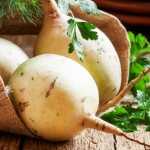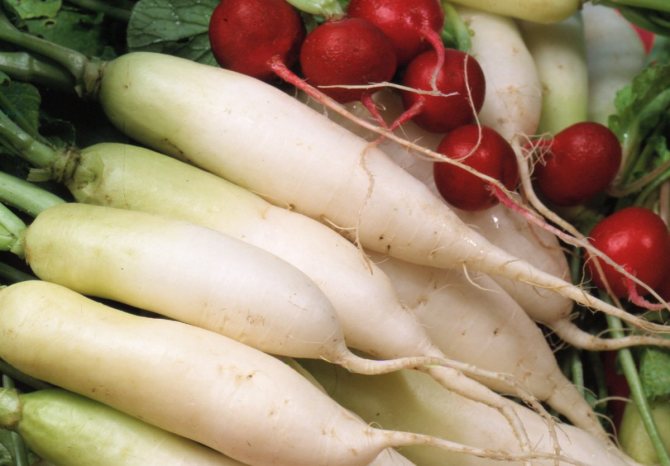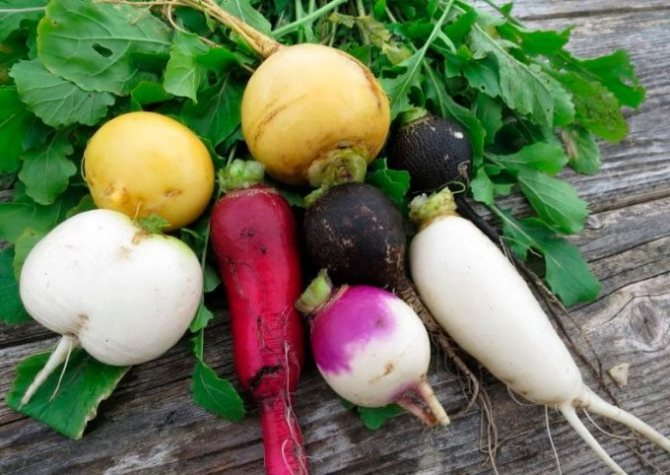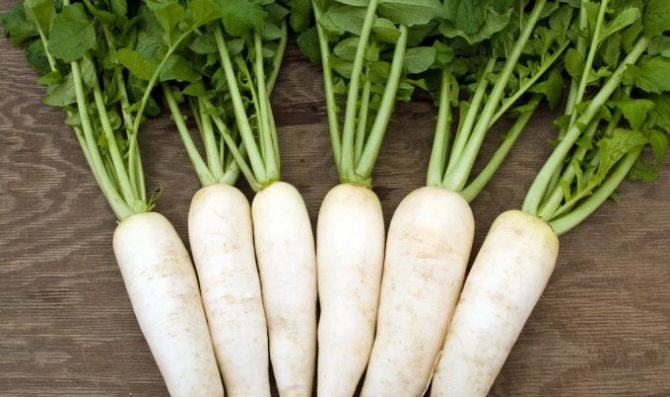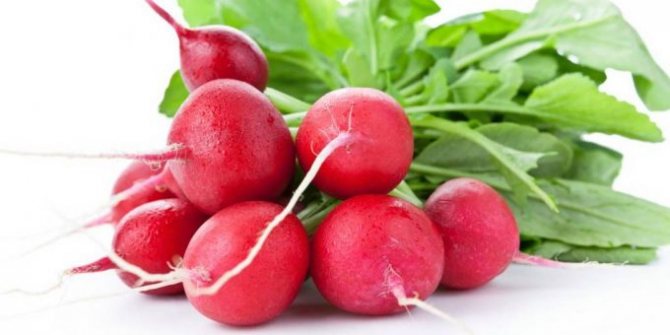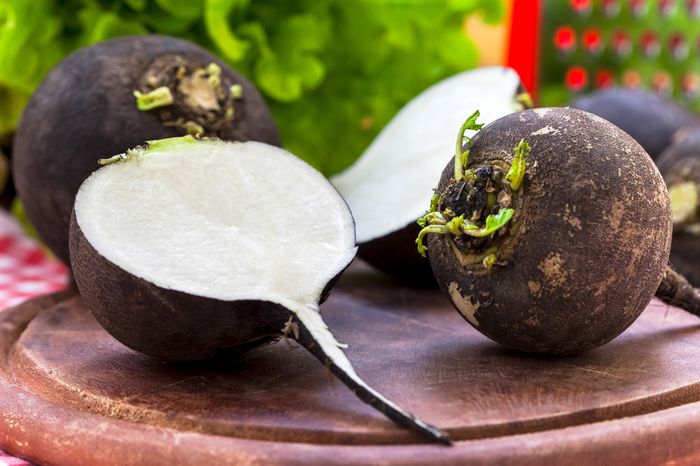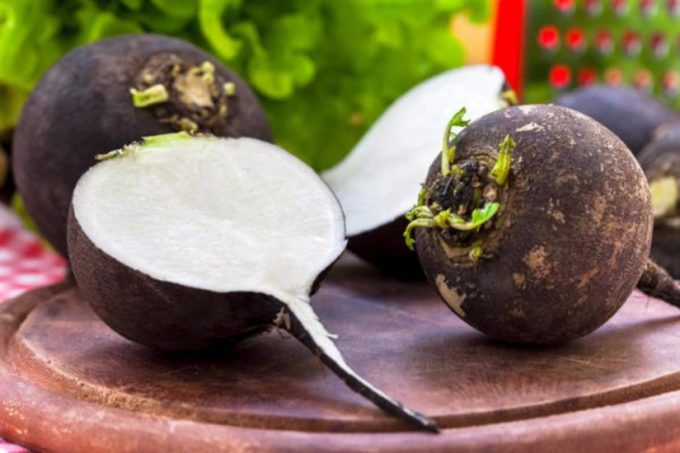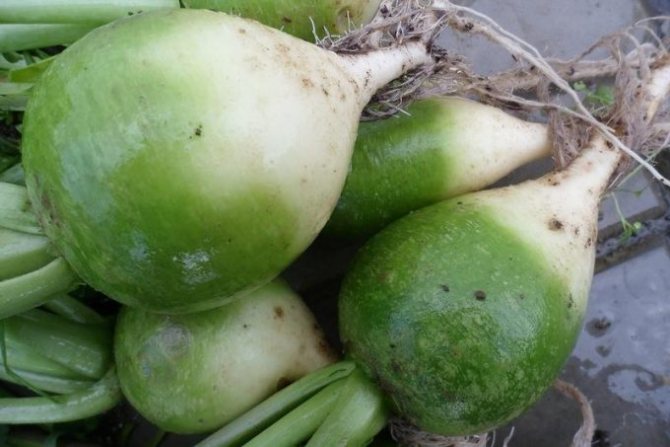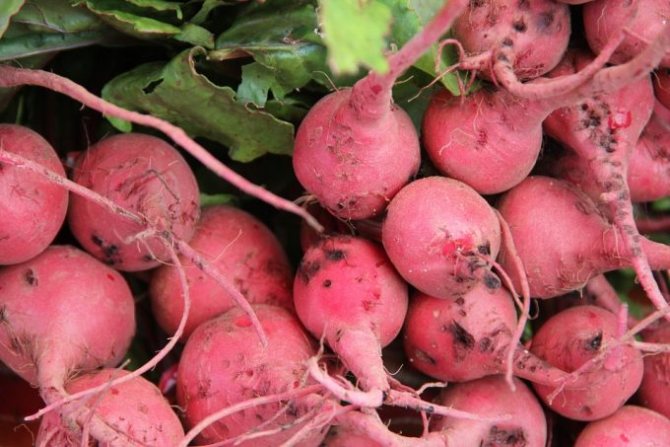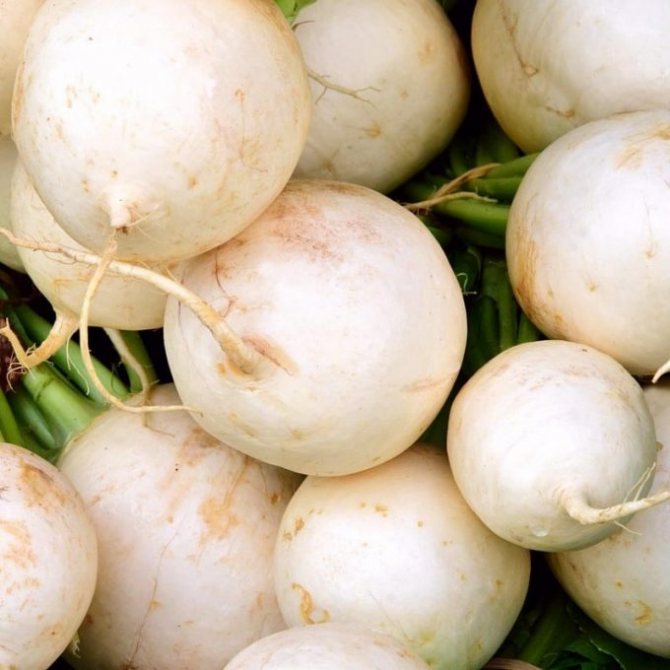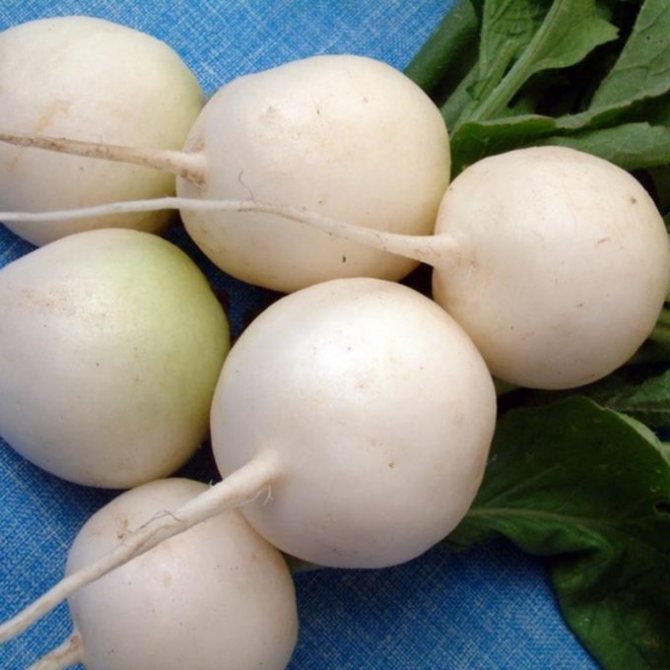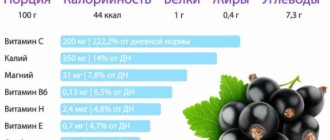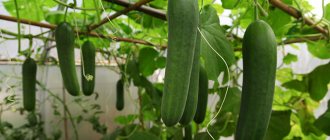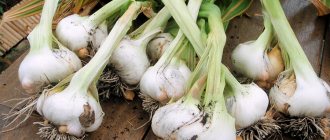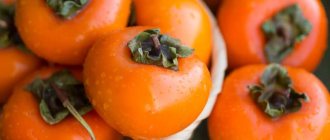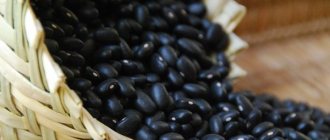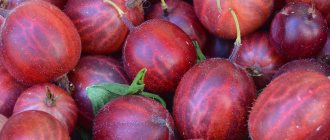A vegetable undeservedly forgotten by the inhabitants of large cities is a radish, the benefits and harm to health of which were known in ancient times. This root vegetable contains a lot of useful substances and has a healing effect on many systems of the human body. There are also contraindications to use, which are worth familiarizing with.
Description of the radish
Even in the days of Antiquity, such a popular garden culture as radish was actively cultivated in the Mediterranean. This small root vegetable belongs to the Cabbage family. The plant has powerful stems with leaves on which fruits are formed - pods. In spring, greens can be used to prepare salads and dressing first courses. The root is fleshy, in the form of a spindle or turnip. The average root vegetable weighs about 0.4-2 kg, and in Japan cultivars are cultivated, reaching 30 kg in weight.
The vegetable is very popular in the Middle East and the Land of the Rising Sun because of its specific spicy-bitter taste with some sweet undertones. The most famous radish varieties with different flavors are:
- black;
- red;
- white;
- green;
- daikon.
The beneficial properties of different varieties of radish are appreciated in dietetics and traditional medicine. The pulp and vegetable juice is used not only for eating, but also for an external agent as an anesthetic, anti-inflammatory and antiseptic. Such actions are due to the rich composition of the vegetable, which gives it a specific taste.
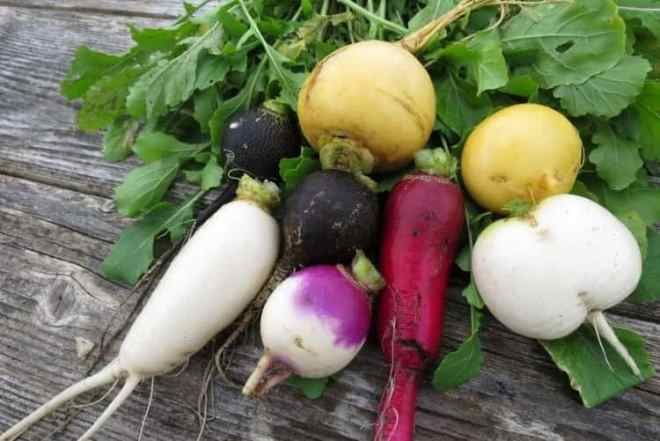
Radish composition
The root crop is a popular source of nutrients during periods of avitominosis - late winter and early spring. Bitter radish, the benefits and harms to human health of which are determined by the composition of the constituent substances, can saturate the body:
- micro and macro elements such as magnesium, iron, phosphorus, potassium and calcium;
- enzymes and enzymes;
- organic acids;
- essential oils.
The vitamins in the radish are very diverse. The largest number are presented:
- B vitamins have a beneficial effect on the functioning of the nervous system;
- beta-carotene is good for the skin;
- ascorbic acid strengthens the immune system, strengthens the vascular walls;
- vitamin E is a natural antioxidant that slows down the aging process;
- vitamin PP improves digestion and heals the skin, hair and nails.
Growing a plant
This is a cold-resistant crop that can be grown at a temperature of about 18 degrees. When grown in the southern regions of the country, roots often become small, their flesh coarsens. The taste becomes more pronounced bitterness.
For summer varieties, planting in open ground in the last decade of April or early May is suitable. For winter varieties of culture, mid-June or July is best suited.
Garden bed preparation
Even a beginner can cope with the preparation of a site for growing a crop. For summer planting, the garden bed is prepared in the spring months. In this place, the earth should be dug up 30 centimeters and fertilized into it. Humus or superphosphate will do. And also compost or potash salt is used. Fertilization of the earth is done if the substrate is infertile.
If seeds are sown in spring, then the planting site must be prepared in the fall.On the dug earth, holes should be made or short grooves should be cut. Three to four seeds are planted in each furrow.
The following proportions should be observed between plantings: 20 centimeters distance between seedlings and 40 cm on rows. If the farmer decides to plant varieties with long roots on his plot, then the distance may be less.
Popular: Choosing planting material, planting and caring for zucchini
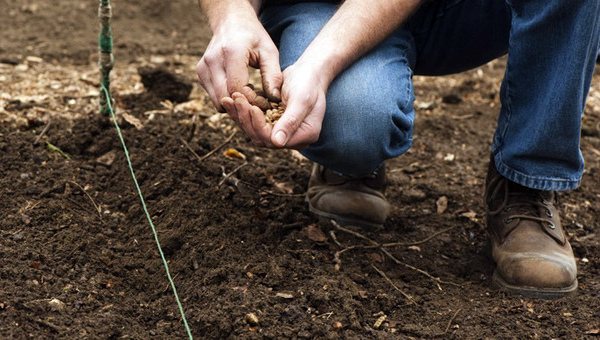

Landing
The seeds of the culture are planted in cut furrows and slightly buried. It is not recommended to bury them more than two to three centimeters from the surface. The spacing between the grooves is at least 20 centimeters.
Mulching the garden bed makes it easier to care for and improves yields, but is optional. After sowing, it is recommended to mulch the garden bed with humus or peat. Then you need to water the plants. After the first seedlings appear, they should be thinned out in order to increase the area for the remaining plants for nutrition and development. Thus, the grower will receive a larger harvest.
The first shoots appear on the seventh day after sowing, but if the plants are grown under a film, then usually the shoots appear in three to four days.
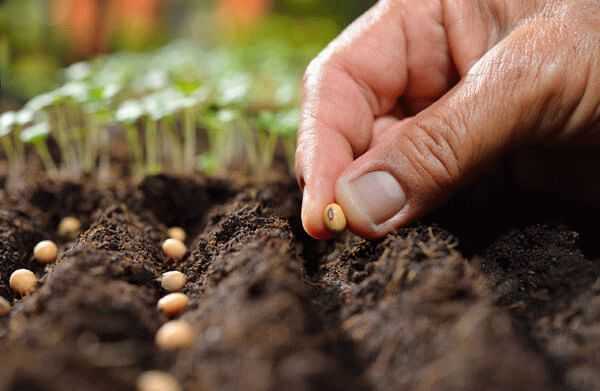

Thinning
The radish must be thinned out in order to get large roots. For the first time, the thinning procedure is done when two or three leaves appear on the seedling. The distance between seedlings should be at least six centimeters.
Re-thinning is done, leaving a distance of at least 12 centimeters between the shoots. If the planting becomes too thick, then part of the radish will simply "go into the tune" and will not form root crops. The fruits obtained from such plants are unsuitable for food.
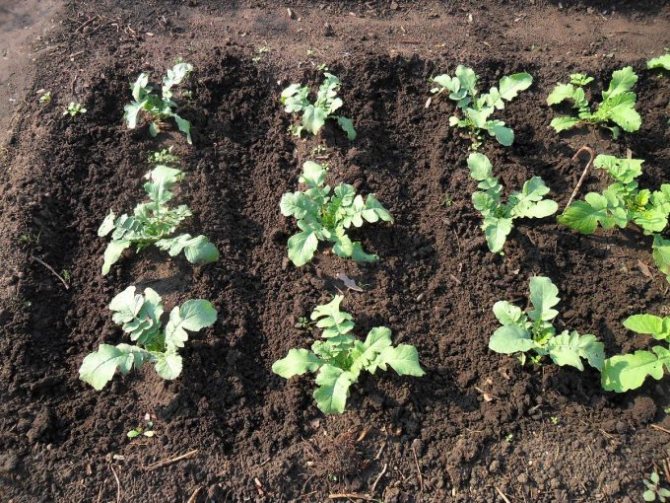

Soil for plants
For growing crops, take a fertile substrate. It can be sandy loam or loam with neutral acidity. Low yields are mainly recorded by gardeners if the root crop is grown in places with heavy soil and where there is a high level of groundwater.
This crop can be planted next to tomatoes and potatoes, cucumbers. It is common to plant plants next to onions, turnips, or radishes.
If it is decided to re-plant the radish, then this is not done on those beds where early ripening varieties of cabbage or radishes, other plants belonging to the Cruciferous family, used to grow.
Watering mode
Radish does not like lack of moisture, so it needs abundant watering. Otherwise, the pulp becomes bitter and the fruit becomes small. In order for the fruits to be tasty, the pulp is juicy, and the bitterness is moderate, experienced gardeners recommend constantly keeping the soil moisture at about 70%.
Watering should be regular. If the plants survive a drought and then receive abundant watering, the roots may simply burst. Therefore, it is impossible for the land in the garden to dry out.
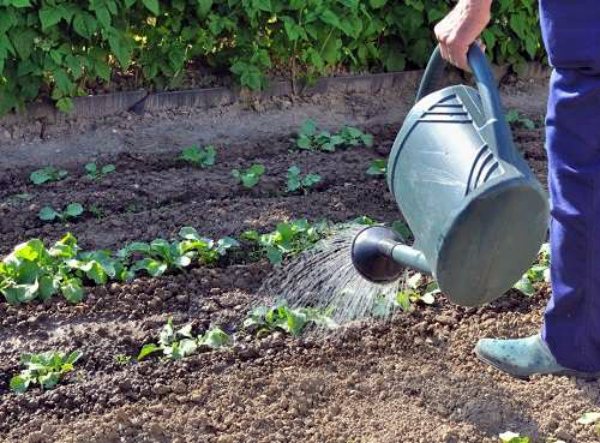

Top dressing
In the future, a bed with plantings must sometimes be loosened and weeded, if it is not mulched. The culture requires regular watering. In addition, the root crop needs to be fed two to three times a season during vegetative growth.
For this, complex fertilizers are used, for example, "Aelita - vegetable", "Kemira". During the ripening of the crop, the plants should be fertilized with compounds that contain potassium. They affect the taste.
Harvesting
The gardener decides when to harvest and how large he needs the radish. The ripening period depends on the variety, weather and climate from 40 to 100 days from the moment of planting.
Pests
The family of such plants can be harmed by the cruciferous flea. A clear sign of defeat by this pest: the leaves become openwork. The gardener must take action in a timely manner, because the affected leaves begin to dry quickly. Ultimately, the plant may die completely or the roots become smaller, acquire a non-standard shape. The best way to defeat the pest is to pollinate with a mixture of wood ash and tobacco dust.
Now read:
- Choosing cucumbers for open ground according to your preferences
- Increased yield of potatoes using Dutch technology
- Planting, care and benefits of savoy cabbage
- Varieties, planting and care of perennial rudbeckia
About
Chief agronomist of the Limited Liability Company "Association of Peasant (Farming) Farms" Kuznetsovskaya "", Ilovlinsky District of the Volgograd Region.
Black radish - benefits and harms
The most useful variety is considered to be black radish, which has a pungent taste and pleasant smell. It is recommended to eat it for:
- improving appetite and stimulating the formation of gastric juice;
- strengthening immunity;
- stimulation of metabolic processes;
- normalization of the stomach and intestines.
In folk medicine, radish juice is used to treat various diseases:
- cleansing the liver and dissolving gallstones;
- healing of purulent ulcers and wounds;
- as a natural antibiotic for the treatment of bronchitis and colds;
- to remove parasites from the body;
- as a diuretic.
Despite all the beneficial properties, if used improperly, the root crop can be harmful to health. The main contraindications for black radish are:
- Diseases of the stomach and intestines in the acute stage.
- Increased acidity of the stomach.
- Allergy to the product and its intolerance.
- Acute pancreatitis and enterocolitis.
- Postponed heart attack.
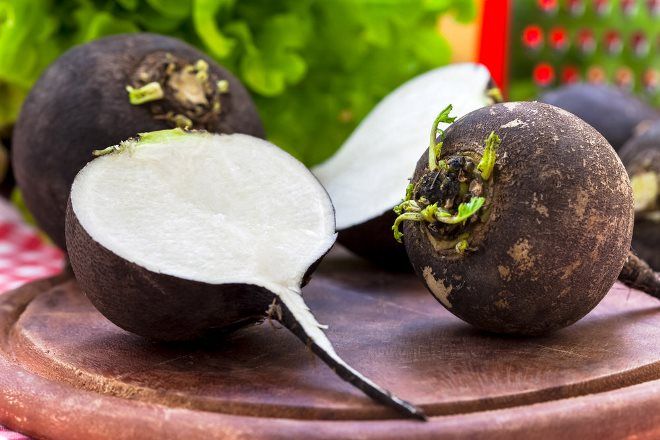

Juice and Pomace Recipes
For kidney and liver stones


Traditional medicine has long proven the assertion that radish dissolves mineral deposits in the kidneys and liver. Our ancestors also emphasized the healing properties of root vegetable juice. One of the most common recipes will be listed below. It is good because it is not difficult to prepare and does not require a large number of ingredients.
Recipe for making black radish from stones:
- Thoroughly wash the tubers with the peel.
- Squeeze out the juice. The resulting cake is not thrown away - it will also be needed.
- We store the juice in the refrigerator in a glass jar. (10 kg radish
3 liters of juice).
- Mix the cake with unsweetened honey (300 g of honey per 1 kg of cake).
- We put the cake in glass jars, knead it as tightly as possible (otherwise mold will start).
Store the cake at room temperature... If the top layer starts to deteriorate, just peel it off.
We take one spoonful of juice after a meal, gradually increasing the dose to half a glass (add a tablespoon each time). Consume until the medicine runs out.
By this time, the cake has already soured, so we begin to take radish with honey. Dosage: 1 to 3 tablespoons with food... We eat the whole cake.
We invite you to watch a video about the treatment of kidneys and liver with radish juice:
For stomach pain
Radish and its juice stimulate the pancreas. And radish essential oils accelerate the secretion of gastric juice, improve blood circulation in the stomach.
Green radish recipe:
- Dilute radish juice with water in a ratio of 1: 4.
- We eat fresh, store in the refrigerator.
We take 0.5 glasses before meals, gradually increasing the dose to 2 glasses per day.
With heart ailments
Radish is known to lower blood pressure by preventing severe and pressing pains.
Relief of pain in the heart with black radish juice:
- Cut a recess at the base of the cut off top of the radish.
- Fill it halfway with honey (can be replaced with sugar).
- Close the hole with the dough.
- Place the radish on an iron sheet in a hot-heated oven or in the oven (for 8-12 hours).
A mixture of juice with honey, formed in the depression, take 0.5 teaspoon for pain in the heart.
For cough and bronchitis
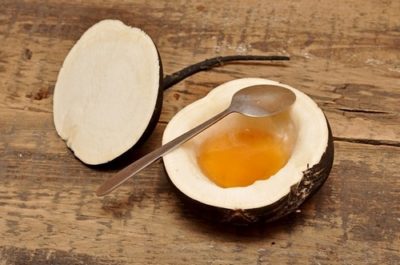

Radish is an amazing vegetable that instantly destroys the foci of an infectious disease. It contains the substance lysozyme, which prevents and neutralizes the growth of bacteria and fungi. This natural remedy also contains glycosides. Thanks to them, harmful microbes simply have no chance of seizing the body.
Black radish cough recipe:
- Rinse medium-sized root vegetable thoroughly.
- We remove the top (do not throw it out, it will be a lid) and cut out a recess.
- Put a spoonful of honey there and wait for the juice to drain.
- Cover with a lid and put away overnight in 12 hours.
Drink syrup three times a day (until complete recovery).
Dosage: teaspoon.
We invite you to watch a video about the treatment of bronchitis with black radish:
Green radish - benefits and harms
Green radish has a similar composition with black radish. However, its taste is somewhat milder. The vegetable is widely available in stores and has a characteristic green skin and flesh color. Asking the question of what the green radish is useful for, you should familiarize yourself with its positive effects on the human body:
- strengthens the immune system;
- has a choleretic effect;
- improves eyesight, condition of teeth and nails;
- normalizes the gastrointestinal tract with reduced gastric secretion;
- stabilizes blood sugar levels;
- helps in the fight against colds.
Contraindications for green radish are similar to the black variety. However, it contains less phytoncides that irritate the gastrointestinal tract, which are acceptable in acute forms of gastritis and ulcers. In moderation, with proper processing, in such cases, the vegetable can be eaten. The root vegetable is also not recommended for heart disease.
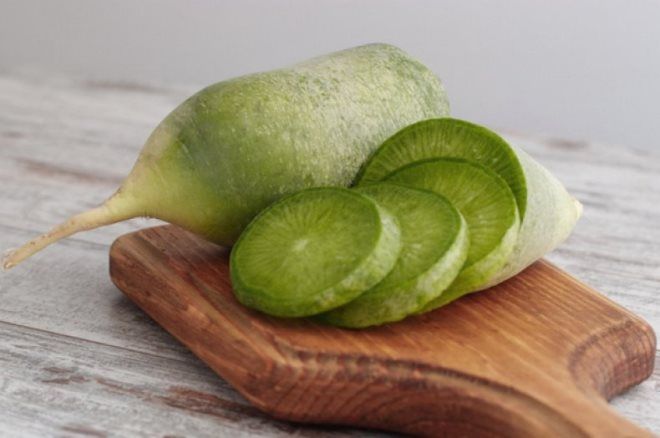

Pink
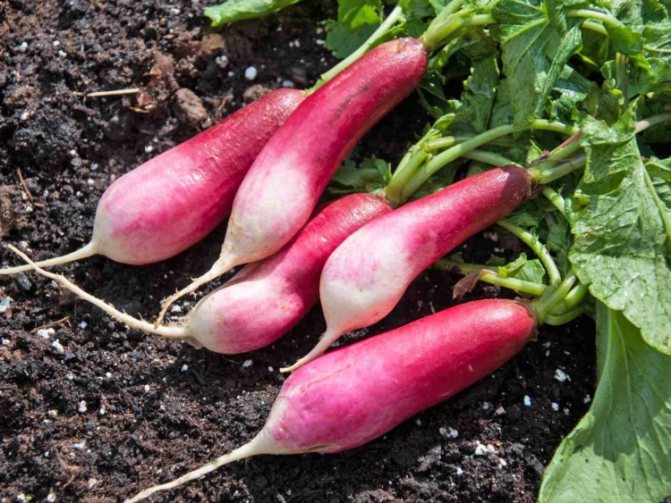

The pink radish is distinguished by the large size of the fruit weighing up to 300-350 grams. Most often round, cylindrical is found (considered a type of lobo). Pink outside and inside. The taste is juicy, soft, slightly spicy. One of the popular varieties is "Daikon Misato".
Varietal features:
- planted by seeds in open ground in early spring;
- needs a long day of light;
- unpretentious to the soil, but neutral acidic is better;
- due to the size of the fruits, they are planted at a distance of 20-30 cm, between the rows - about 50 cm;
- requires loosening of the soil and hilling;
- loves moisture, with a lack it will taste bitter;
- does not last long.
We offer you to watch a visual video about the Daikon Misato radish Pink glitter:
White radish - benefits and harms
White radish has a special pungent taste with a slight bitterness. This variety is often used in cooking for a wide variety of dishes. The benefits of radish for the body are similar to other varieties of root crops:
- diuretic and choleretic effect;
- activation of metabolic processes and strengthening of immunity;
- fight against viruses and bacteria;
- improving the functioning of the digestive system;
- sedation and fight against depression and loss of energy;
- in cosmetology, it is used as a cleansing and bleaching agent.
The vegetable is contraindicated for people who have:
- severe history of heart and kidney disease;
- with exacerbations of diseases of the stomach and intestines;
- an allergy or root intolerance has been identified;
- pregnant women should not eat it, since organic acids can increase the tone of the uterus.
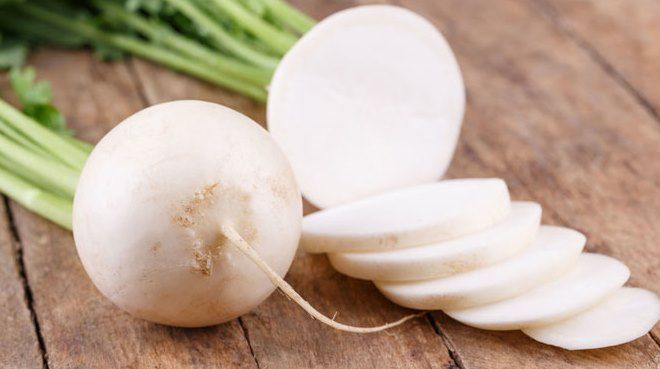

Cooking use
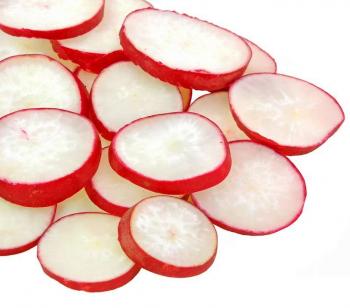

Useful red radish in cooking most often used fresh
.
It serves as the basis for a variety of summer and winter salads.
In addition, chopped root vegetables can be used in various dishes, both vegetable and meat.
Thanks to the use of red radish, other foods are absorbed much faster.
Root vegetables add incredible flavor and spicy aroma to the final dish. In some countries, red radish is amenable to heat treatment, for example, it can be boiled, stewed and fried
.
Red radish - benefits and harms
This variety is considered a hybrid of black radish and radish. It has a pronounced bitter taste with a small share of pungency. It is often eaten raw in salads and as an additive to marinades. All the beneficial properties of the parent variety were transferred to the red root vegetable, however, it is used less often in folk medicine. Red radish can be harmful to people with diseases of the heart, stomach and gallbladder, pregnant women and allergy sufferers.
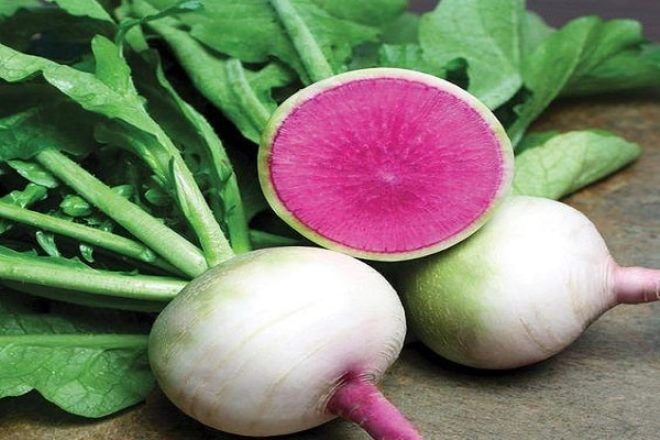

Storage
Red radish is not intended for long-term storage. The fruits soften and deteriorate after 5-6 days. But if you put them in the refrigerator, the storage time will increase several times. But before that, it is important to properly prepare the daikon:
- remove spoiled areas, and it is better to sort out such fruits altogether;
- pack the crop in plastic bags;
- make holes in each package for air intake.
The optimum temperature at which the radish is stored is from +1 to -2 degrees. Relative humidity also plays an important role. Its optimal performance is no more than 90%.
Later varieties of daikon can be stored for a long time. They are piled up and covered with earth. They stay in this state for up to 15 days until they are completely dry. Winter varieties are stored in the basement or in the refrigerator. Before storage, the fruits are sorted and sorted in the same way. It is also important to regulate the air temperature in the basement, it should not drop below 0 degrees.
Daikon radish - health benefits and harms
Most oriental salads are not complete without daikon radish, which in appearance resembles white carrots. It has a pronounced pungent taste with a certain amount of softness and juiciness. The benefits of daikon are rightfully appreciated by the Japanese, who love the vegetable for:
- improved heart function;
- reduction of edema;
- normalization of the nervous and endocrine systems;
- insulin production;
- reducing the risk of cancer;
- increased potency.
You should not use Japanese radish for people who:
- have problems with the thyroid gland;
- suffer from diseases of the stomach and intestines;
- have stones in the bile duct.
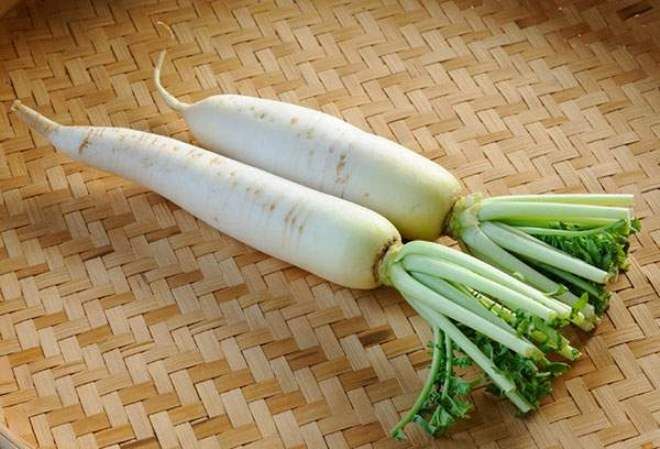

Popular varieties
The following varieties of bright vegetables are best known:
- "Würzburg": large round roots have a raspberry hue, suitable for long storage;
- "Red giant": the root crop has an oblong shape up to 12-13 cm long, winter variety, well stored;
- "Dahunpao" (from Chinese "Big red dress"): root crops have a spherical shape with a diameter of up to 10-12 cm, summer variety;
- "Vavalyan" (from Chinese "Child's face"): it can be recognized by the combination of the red color of the whole fruit with white tips, summer variety.
Red radish, while not requiring a lot of time to grow, meanwhile, adds variety to the usual diet. Therefore, in each garden season, it is worth allocating a place in the garden to a healthy vegetable.
The peculiarity of the pink radish is that it is rather large in size. The weight of one fruit reaches 300 grams. Disputes about the origin of the daikon are still ongoing. Some scientists believe that this is the result of crossing a radish with a radish. Others stubbornly consider it an ordinary large-sized radish. This culture is characterized by juicy pulp, which is why it has become a favorite of many gardeners.
The root vegetable has a dense and juicy pulp. As a rule, the radish is round in shape, but some varieties are characterized by elongated fruits that resemble a cylinder. The inside of the fruit is white, and the thin layer of the rind is red in color. Although many hybrids have already been bred that have opposite characteristics, namely red flesh and white rind.
The fruit is moderately spicy to taste. The advantage of the radish is that it is a storehouse of substances useful for the body. The coarse fibers in its composition are known for their positive properties on the digestive system. In addition, radish cleanses the body of harmful toxins, improves appetite, and prevents constipation. The antibacterial properties of the vegetable allow you to cope with pathological processes in the intestines.
If you regularly eat the vegetable, you can prevent swelling, as it helps to remove excess fluid from the body.
Slimming radish
The vegetable is very useful in the fight against excess weight. The calorie content of a radish, depending on the variety, varies from 20 to 35 kcal per 100 g of product.Low nutritional value, combined with a large amount of nutrients in the composition, make the vegetable recommended not only for special diets for weight loss, but also for periodic fasting days. At this time, you can eat both vegetable salads with the addition of spicy root vegetables, and pickled, stewed and boiled side dishes.
Finding out what a radish is, the benefits and harms to the health of this root crop, let us dwell on the properties that are important for losing weight:
- The fiber included in the composition helps cleanse the intestines from toxins and toxins.
- The available minerals will maintain the water-salt balance, which will remove the swelling.
- Resists the accumulation of fat and cholesterol.
- Helps to improve the process of digestion and metabolism.
The best varieties
Each type of radish has subspecies that differ in some characteristics. Breeders have developed many hybrids that are popular in Russia, possessing the desired properties and allowing the plant to be cultivated in all regions of the country. The main division of subspecies occurs according to the duration of the growing season. Most of them are suitable for growing in the middle lane.
Radish varieties according to the ripening period to the technical ripeness of root crops:
- the early ones mature in 40-65 days, are often characterized by increased cold resistance, but many are poorly stored;
- mid-ripening - the growing season is 65-90 days, are considered universal varieties cultivated in all regions, have good keeping quality;
- the late ones ripen in 90-120 days, are grown when it is required that the harvest be stored until spring. The main disadvantage is that they do not always have time to reach commodity maturity.
Early ripening
- Mayskaya radish is used for spring planting, ripens in 55-65 days. Root crops are round with a sharp end, up to 20 cm long, with a maximum weight of 200 g, the surface of the peel is white. The middle is juicy, slightly pungent, whitish in color. The variety stands out for its resistance to cracking, surface without small roots. Dense plantings, dryness and dense crust on the soil should not be allowed, as this leads to flowering.
- Black dragon - growing season 50-65 days. The marketable vegetable is elongated, cylindrical, slightly pointed at the bottom, grows up to 17 cm, weighs 150-210 g. The peel is black, the flesh is whitish, juicy, with a slight spike, sweet in taste. Resistant to flowering, keeping quality and productivity are good.
- Margelanskaya radish ripens in 60-90 days. A rounded-elongated marketable vegetable of greenish color with a whitish pointed end, up to 17 cm in size, weighing 220-400 g. The flesh is white, juicy, almost without bitterness. Differs in keeping quality, suitability for long-distance transportation, it is used fresh. It is sown outdoors in summer, depending on the region, from late June to mid-July.
- Ladushka - red roots, similar to a cone, weighing up to 150 g, with white pulp, characterized by a delicate, juicy structure. The variety is valued for its stable yield and rich vitamin composition. Duration of storage is 2 weeks, under unfavorable conditions it is arrowed.
- Radish Zlata ripens in 20-25 days. The shape is round, 5-7 cm in diameter. The pulp of yellow radish is distinguished by its juiciness, delicate, pleasant taste. It is appreciated for its resistance to flowering, the ability to grow all summer.
# gallery-6 {margin: auto; } # gallery-6 .gallery-item {float: left; margin-top: 10px; text-align: center; width: 33%; } # gallery-6 img {border: 2px solid #cfcfcf; } # gallery-6 .gallery-caption {margin-left: 0; } / * see gallery_shortcode () in wp-includes / media.php * /
May Ladushka Zlata
Medium ripening
- Daikon Uncle Stepa ripens in 72-80 days. White, long, cylindrical roots weigh up to 400 g. The structure is juicy, crispy, tender, the cut is white. It is consumed fresh. The variety is cold-resistant. Timely watering, deep tillage, thinning of dense plantings are required.
- The winter round black radish has a ripening period of 70-93 days. Black commercial turnips grow up to 11 cm in length and 8-12 cm in diameter. The shape is round or flat-round.The pulp is white, juicy, with a slight sharpness. It is appreciated for its ability to be stored for a long time, yield, beneficial effect in case of colds, diseases of the nasopharynx, lungs and bronchi.
- Chinese radish Hostess belongs to watermelon varieties, ripens in 65-75 days. Light greenish vegetable with a short cylinder shape, up to 12 cm long, 7-9 cm in diameter, weighing 110-150 g. On the cut, pink, juicy, high taste. Grown using summer planting (late June - early July), but can be sown in early May.
- The lady is ready for cleaning from the beds in 65-68 days. A red vegetable of a rounded shape with a sharp tip, weighing 80-120 g. The pulp is white, juicy, distinguished by its taste. The variety is a high-yielding variety, sown in open ground from mid-June.
- Radish Würzburg 59 is ready for use in 25-35 days. A red-crimson turnip is round in shape, weighing 14-17 g. The pulp is juicy, white, does not dry out for a long time. The variety is characterized by high productivity, resistance to flowering.
# gallery-7 {margin: auto; } # gallery-7 .gallery-item {float: left; margin-top: 10px; text-align: center; width: 33%; } # gallery-7 img {border: 2px solid #cfcfcf; } # gallery-7 .gallery-caption {margin-left: 0; } / * see gallery_shortcode () in wp-includes / media.php * /
Lady Uncle Stepa Wurzburg Winter Hostess
Late
- Black radish has a ripening period of 90-95 days. Black roots are round-oval, weighing up to 300 g. The pulp is slightly pungent, juicy, white. Differs in taste, good yield, flat surface of root crops. The variety is suitable for long-term storage, retains its commercial qualities for a long time. It is advisable to eat it fresh.
- Gaivoron radish ripens in 110-120 days. White roots grow up to 50 cm long, with an average weight of 2 kg. The pulp is dense, very sharp, slightly juicy, white in color. The variety is high-yielding, used for winter storage, resistant to cold and blooming.
- Radish Ice icicle ripens in 35-40 days. The root crop is cylindrical, long (up to 15 cm), white in color. The pulp is medium sharp, very juicy. Differs in high yield, cold resistance, resistance to sagging and shooting.
# gallery-8 {margin: auto; } # gallery-8 .gallery-item {float: left; margin-top: 10px; text-align: center; width: 33%; } # gallery-8 img {border: 2px solid #cfcfcf; } # gallery-8 .gallery-caption {margin-left: 0; } / * see gallery_shortcode () in wp-includes / media.php * /
Gaivoronskaya Ice Icicle Black Woman
The species and varietal variety of radish allows you to choose a vegetable with the desired severity of pungency and bitterness, given useful properties. The unusual appearance allows many types to be used for decorating dishes. The winter storage ability of the varieties will provide vitamins and minerals for the whole year.
Many people know radish, but not everyone grows it in their garden. Meanwhile, it is not only tasty, but also very useful, healing vegetable. If you have not yet had time to get to know him, now is the time to do it so that in the coming season you will find a place for the radish in your beds.
Many people know radish, but not everyone grows it in their garden

